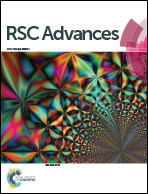Theoretical insight into the binding affinity enhancement of serine with the uranyl ion through phosphorylation†
Abstract
To study the coordination modes and the binding affinities of uranyl ions with serine and phosphoserine, 1 : 1, 1 : 2 and 1 : 3 type complexes of a uranyl ion with these ligands were optimized at the B3LYP/ECP60MWB-SEG/6-311+G(d)/SMD level of theory in an aqueous solution. The analyses of the electronic energies show that the uranyl ion tends to adopt a penta-coordination mode and the binding affinity of the uranyl ion toward three functional groups follows the order of –PO42− > –COO− > –PO4H−. The changes of the Gibbs free energy (ΔGsol) for the studied reactions suggest that the uranyl ion prefers to form a 1 : 3 type complex with these ligands. Moreover, the absolute values of ΔGsol increase for the phosphorylated serine with the same type of reaction. Based on the thermodynamic results, a higher solution pH is more favorable for uranyl ion coordination with phosphoserine. This work could render theoretical insights into the specific coordination modes of uranyl ions with serine/phosphoserine under different conditions and provide useful information for further study on the interactions between actinide cations with peptides and proteins.


 Please wait while we load your content...
Please wait while we load your content...